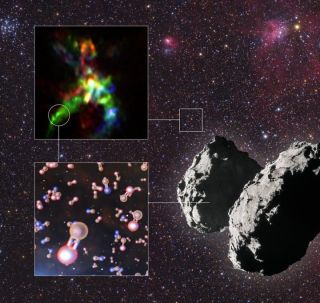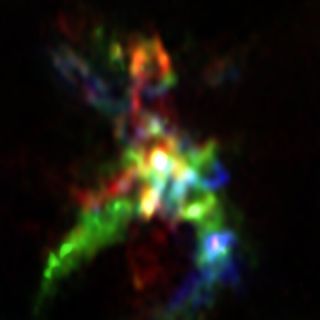Astronomers just tracked the interstellar journey of one of life’s building blocks through space – Space.com
Scientists have traced the journey of phosphorous, one of the essential building blocks for life as we know it on Earth, through the star-forming regions of space.
Phosphorous, an element present in our DNA and RNA and in cell membranes, is a critical ingredient for life on Earth. But scientists don’t have a clear picture of exactly how the element made its way to our young planet and exactly how life began. However, with a new study, researchers continue to piece together the story of how life began.
“Life appeared on Earth about 4 billion years ago, but we still do not know the processes that made it possible,” Víctor Rivilla, the lead author of this new study, said in a statement.
For this study, astronomers used data from the Atacama Large Millimeter/Submillimeter Array (ALMA), the European Southern Observatory (ESO) and the Rosetta probe from the European Space Agency. With this data, they were able to trace the journey of phosphorous from star-forming regions (regions of gas and dust in between stars where planetary systems form) to comets.
Related: 10 Exoplanets That Could Host Alien Life

ALMA was able to give the researchers an up-close, detailed look at the star-forming region AFGL 5142. These observations showed the astronomers where phosphorous-bearing molecules form, and that these molecules are created as massive stars form.
The team found that gas from young, massive stars created openings in the star-forming interstellar clouds, and on the walls of those cavities, phosphorous-bearing molecules form. Additionally, they found that phosphorous monoxide was the most abundant of these types of molecules.
In addition to studying how phosphorous is created in star-forming regions, the team studied the comet 67P/Churyomov-Gerasimenko, which the Rosetta probe was sent to observe. They hoped that by following the trail of these phosphorous-bearing molecules from where they originated, they might see how those molecules can get trapped in the icy dust grains that surround a star.

If that happens, the researchers estimated, those icy dust grains that now hold phosphorous-bearing molecules could come together to eventually form comets. And, ultimately, those comets could deliver the molecules, and therefore phosphorous, to Earth.
With data from the ROSINA (Rosetta Orbiter Spectrometer for Ion and Neutral Analysis) instrument on the Rosetta probe, astronomers had previously found hints of phosphorous in the comet, but they couldn’t explain how had gotten there.
In working to confirm what molecule could have left these “hints” on the comet, Kathrin Altwegg, the principal investigator for ROSINA and one of the authors of this new study, said that they were approached at a conference by an astronomer who studies star-forming regions with ALMA.
“She said that phosphorous monoxide would be a very likely candidate, so I went back to our data and there it was,” Altwegg said in the statement.
In showing the presence of phosphorous monoxide on the comet combined with the data from ALMA, these researchers have “revealed a sort of chemical thread during the whole process of star formation, in which phosphorus monoxide plays the dominant role,” Rivilla said.
Regarding the larger picture, this work provides further evidence of how phosphorous may have arrived on an early Earth, and how it may have contributed to the origins and development of life.
“Phosphorus is essential for life as we know it,” Altwegg said. “As comets most probably delivered large amounts of organic compounds to the Earth, the phosphorus monoxide found in comet 67P may strengthen the link between comets and life on Earth.”
The work was released today (Jan. 15) and presented in a paper to appear today in the journal Monthly Notices of the Royal Astronomical Society.
Follow Chelsea Gohd on Twitter @chelsea_gohd. Follow us on Twitter @Spacedotcom and on Facebook.






